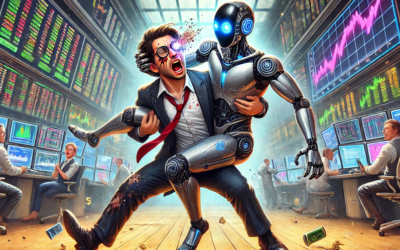Random Entry Trading
There is a famous trading book that ‘proves’ you can enter the market with a random entry and still make money. Or did it prove that? There are some important lessons to be learnt when we take a deeper look.
The trading strategy was simple:
1 – Enter the market at random
2 – Use a trailing stop loss to exit the trade
Now, of course, the authors didn’t actually trade the system, they just showed how it would have worked on a number of markets over a 10-year period. In that period, the system made a profit.
So, can we stop learning anything else about trading, use these 2 rules and retire to an island somewhere?
Probably not.
Let’s have a think about what this strategy does. First, we enter the market. It doesn’t matter if we go long or short. We have a trailing stop loss order that will follow the market if it moves in the direction of the trade and will sit where it is if the market moves against us.
If the market is trending, then the random entry trades that are against the market will quickly get stopped out. On the other hand, the trailing stop will ensure that the random entry trades that go with the market will ride the trend. So, of course, the winners will be larger than the losers. That’s where the profit comes from.
So, what’s the problem?
Well, the problem is that this is not a profitable system, and it’s not really a completely random system. It’s a trend following system. It makes profit when the market is trending, and it loses money when the market isn’t trending. In the book, the back-test showed markets that were predominantly trending.
Don’t agree? There are options strategies that do the same thing. The “Long Straddle” is a strategy where you buy a call and a put option with the same strike price. Effectively, you are saying “I know it’s going to move, I just don’t know which way”. It’s not a random entry, it’s a ‘prediction’ that volatility will increase. There’s nothing random about that. The system described in the book is doing the same thing. If the market went into range mode as it did for most of 2016, your random entry system would lose.
So what?
There are a few lessons to learn from this. First, the fact is that it’s your overall strategy that makes you profitable (or not). The decisions you make to get into the market may not be the most important element.
The reasons that a strategy is making or losing money may not be obvious. In this case, we had 2 authors who wrote a chapter in a book “proving you could trade at random”. In fact, they’d just proved you could follow a trend. Let’s give the authors the benefit of the doubt and presume they were not trying to fool people. They effectively fooled themselves. They were so focused on the entry being random that they missed the fact that the exit made it a trend following system.
Of course, the chapter mentioned nothing about trend following. The most important part of any trend following system is how to know if the market IS trending. Without that, a trend following system will fail (unless, like the authors, you were lucky enough to test only in trending markets).
Playing with numbers
If you have access to any back-testing software, you will find that if you enter at random with a 9 tick stop loss and a 1 tick target, it will result in an amazing 90% win rate. The problem, though – even with the 90% win rate, you would not make any money. There is no edge in the system. When your stop is 9 ticks away and your target 1 tick away, that alone will see you hitting your target far more frequently. You will win more trades than you lose, but the system will break even before spreads/commissions.
This is an important thing to keep in mind. If you play with your stops/targets too much, randomly introducing different numbers to improve your strategy, you risk negating your edge. For example, let’s say we trade a strategy that looks for trapped traders on Crude Futures, something that will typically give us a 10-20 tick bounce. Then say your back-testing found that a 10-tick target and a 200 tick stop loss gave you the best results. What you’d have is some trades that hit your target because of the trapped traders and some trades that hit the target because although the trap failed, the target is so much closer than the stop. You are left with something quite random and that won’t play out well in a live market.
Nuance
Randomness isn’t all about trading at random. Any entry signal will have a finite scope. The 10 tick bounce we see when we have trapped traders in Crude Futures will occur in minutes, and it’ll be over after the market has moved 10-20 ticks. If we are still in that trade 3 days later, then we aren’t trading the reaction to those trapped traders any more. We are in the market because it carried on moving, not because our analysis told us it would carry on moving. In other words – it’s random.
Then there are times when we ‘feel’ we are trading at random because people think a trading strategy is all about the entry. Yet what you do after the entry is as much a part of the strategy as the entry itself and will dictate under which circumstances you do and don’t make money.
Trading can be random when you think it isn’t and vice-versa. Something to keep in mind next time you shout “Eureka!”.
Simplify Your Trading
Take a look into the decision making process of professional traders with this video training series that helps you make smarter trading decisions.




0 Comments